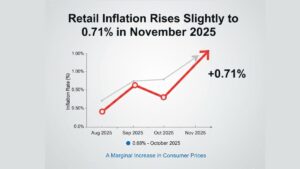India has witnessed significant employment growth over the years. With employment increasing by nearly 36%, adding around 17 million jobs during 2016-17 and 2022-23, India’s economic trajectory demonstrates sustained job creation across key sectors. With a robust democracy, dynamic economy, and a culture that celebrates unity in diversity, India’s journey toward becoming a global powerhouse continues to inspire the world.
Significant Increase in Employment
- Employment in India has grown by 36%, adding around 17 million jobs between 2016-17 and 2022-23.
- This growth showcases a sustained trend of job creation across various sectors, contradicting the notion of “jobless growth.”
A Shift Away from “Jobless Growth”
Challenging the Myth
- A report from the Observer Research Foundation titled ‘Busting the Myth of Jobless Growth’ presents data countering claims of jobless GDP growth.
Key Findings
- GDP Growth: Average GDP growth exceeded 6.5% during the same period of employment increase.
- KLEMS Database: Data from the Reserve Bank of India’s KLEMS database indicates steady employment growth since the 1980s.
- Worker Population Ratio (WPR): Increased by 9 percentage points (almost 26%) from 2017 to 2023.
Driving Factors Behind Employment Growth
- Consumption-Driven Growth : Employment generation is closely linked to consumption patterns; rising consumption suggests job creation.
- Employment Elasticity : An increase of 1.11% in jobs for each 1% increase in value added from 2017-23.
- Sectoral Observations : The labor-capital ratio indicates that services contribute positively to job creation, contrary to previous assumptions.
Economic Survey of India Highlights
Improved Labor Market: Indian labor market indicators have improved significantly with the unemployment rate declining to 3.2 per cent in 2022-23.
Sectoral Employment: Agriculture remains dominant, employing over 45% of the workforce, though there is a gradual shift toward manufacturing and services.
Youth Employment: According to PLFS, youth (age 15-29 years) unemployment rate has declined from 17.8 per cent in 2017-18 to 10 per cent in 2022-2
Female Workforce Participation: The female labor participation rate has steadily increased due to supportive policies.
Manufacturing Recovery: Factories employing over 100 workers experienced 11.8% growth between FY18 and FY22, indicating that larger industrial units are creating more jobs than smaller ones.
Wage Growth: During FY15-FY22, the wages per worker in rural areas grew at 6.9 percent CAGR visà-vis a corresponding 6.1 per cent CAGR in urban areas.
- This growth reflects the rising demand for labor in rural industries such as construction and manufacturing, as well as public employment programs like Mahatma Gandhi National Rural Employment Guarantee Act (MGNREGA).
EPFO Payroll Growth: The yearly net payroll additions to the EPFO have more than doubled from 61.1 lakh in FY19 to 131.5 lakh in FY24, driven by new job creation and greater formalization of employment.
Gig Economy: India’s gig economy is expanding rapidly, with the workforce in this sector expected to grow to 2.35 crore by 2029-30.
Manufacturing and AI: The manufacturing sector remains shielded from automation, offering continued job growth opportunities.
General Details about some topics mentioned above
Labour Force Participation Rate (LFPR)
- LFPR is the percentage of the working-age population (aged 15 years and above) that is either employed or unemployed, but willing and looking for employment.
Worker Population Ratio (WPR)
- WPR is defined as the percentage of employed persons in the population.
- Symbolically, Worker Population Ratio. = Total Number of WorkersTotal Population×100.
Unemployment Rate (UR)
- UR is defined as the percentage of persons unemployed among the persons in the labor force.
Periodic Labour Force Survey
- It is a survey conducted by the NSO under the Ministry of Statistics and Programme Implementation (MoSPI) to measure the employment and unemployment situation in India.
- The NSO (National Statistical Office) launched the PLFS in April 2017.
Objective of PLFS
- To estimate the key employment and unemployment indicators in the short time interval of three months for the urban areas only in the ‘Current Weekly Status’ (CWS).
- To estimate employment and unemployment indicators in both ‘Usual Status’ and CWS in both rural and urban areas annually.
| Summary/Static | Details |
| Why in the news? | India has witnessed significant employment growth over the years. With employment increasing by nearly 36%, adding around 17 million jobs during 2016-17 and 2022-23 |
| Employment Growth | (2016-17 to 2022-23) 36% increase, adding around 17 million jobs. |
| GDP Growth (2016-17 to 2022-23) | Average growth of 6.5% annually. |
| Worker Population Ratio (WPR) | Increased by 9 percentage points (26%) from 2017 to 2023. |
| Economic Survey Data Highlights are Below | |
| Youth Unemployment (2017-18 to 2022-23) | Declined from 17.8% to 10%. |
| Female Workforce Participation | Steady increase due to supportive policies. |
| Sectoral Employment Agriculture | 45% of the workforce. Gradual shift towards manufacturing & services. |
| Manufacturing Sector Growth | Factories with >100 workers grew by 11.8% between FY18-FY22. |
| Wage Growth (FY15-FY22) | Rural wages: 6.9% CAGR, Urban wages: 6.1% CAGR. |
| Gig Economy Growth | Projected to employ 2.35 crore by 2029-30. |
| Employment Elasticity (2017-23) | 1.11% increase in jobs for each 1% increase in value-added. |




 India’s Forex Reserves Rise by $1.68 Bil...
India’s Forex Reserves Rise by $1.68 Bil...
 India’s Net Direct Tax Collections Rise ...
India’s Net Direct Tax Collections Rise ...
 Retail Inflation Rises Slightly to 0.71%...
Retail Inflation Rises Slightly to 0.71%...







